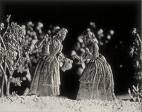
Photogravure registers a wide variety of tones, through the transfer of etching ink from an etched copperplate to individual dampened paper run through an etching press. The unique tonal range comes from photogravure's variable depth of etch, that is, the shadows are etched many times deeper than the highlights. Unlike half-tone processes which just vary the size of dots, the actual quantity and depth of ink wells are varied in a photogravure plate and are often blended into a smooth tone by the printing process. Photogravure practitioners such as Peter Henry Emerson and others brought the art to a high standard in the late 19th century. The speed and convenience of silver-gelatin photography eventually displaced photogravure which fell into disuse after the Edward S. Curtis gravures in the 1920s. Many years later, photogravure has experienced a revival in the hand of Aperture and Jon Goodman, who studied it in



